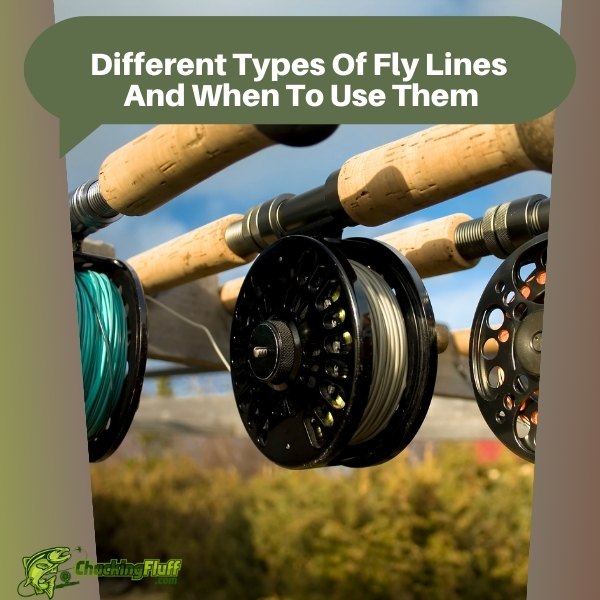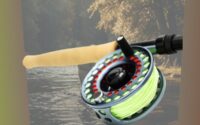| Disclosure: Just to be open and honest the buttons and links you click on in the website will in most cases take you to another website where you can purchase the products I am reviewing. As an Amazon Associate I earn from qualifying purchases. |
Different Types Of Fly Lines And When To Use Them

Fly fishing enthusiasts understand the critical role that fly lines play in their pursuit of the perfect catch. Choosing the right type of fly line can significantly impact casting accuracy, presentation, and ultimately, success on the water. In this comprehensive guide, we’ll delve into various types of fly lines, their characteristics, and when each excels in fishing scenarios.
Quick Post Navigation
- Introduction to Fly Lines
- Weight Forward (WF) Fly Lines
- Double Taper (DT) Fly Lines
- Shooting Taper Fly Lines
- Sink Tip Fly Lines
- Full Sinking Fly Lines
- Intermediate Fly Lines
- Floating Fly Lines
- Specialty Fly Lines (e.g., Nymph Lines, Saltwater Lines)
- Choosing the Right Fly Line for Specific Fish Species
- Factors Influencing Fly Line Choice
- Maintenance Tips for Fly Lines
- Common Mistakes in Selecting Fly Lines
- Conclusion
- FAQs about Fly Lines
- “Check out some of our other Buying Guides”
Introduction to Fly Lines
Fly lines are specialized lines used in fly fishing that allow anglers to cast artificial flies using a fly rod. Unlike conventional fishing lines, fly lines are thicker and heavier at the front (the “head”), tapering down to a thinner diameter at the back (the “running line”). This unique design facilitates delicate presentations of flies on the water’s surface or just beneath it.
Weight Forward (WF) Fly Lines
Weight forward fly lines are the most common type used by anglers worldwide. They feature a thicker, heavier section at the front (the “head”), which allows for easier casting and better accuracy over longer distances. This design makes WF lines versatile for various fishing conditions, from small streams to large rivers and lakes.
Double Taper (DT) Fly Lines
Double taper fly lines have a uniform thickness throughout most of the line, tapering gradually at both ends. This design provides delicate presentations and is favored by anglers who prioritize accuracy and smooth casting in short to medium distances. DT lines are versatile and can be easily reversed for prolonged use.
Shooting Taper Fly Lines
Shooting taper fly lines are designed for maximum distance casting. They have an extended, thin running line that allows for reduced friction through the rod guides, enabling anglers to shoot the line effortlessly over long distances. Shooting taper lines excel in situations where reaching distant targets is crucial, such as when fishing large rivers or in windy conditions.
Sink Tip Fly Lines
Sink tip fly lines feature a sinking front section (the “tip”) attached to a floating line. This hybrid design allows anglers to present flies at various depths, making them ideal for fishing in deeper waters or swift currents where a deeper presentation is necessary while keeping the majority of the line floating for better control and mending.
Full Sinking Fly Lines
Full sinking fly lines are uniformly dense and sink entirely beneath the water’s surface. They are invaluable for fishing deep waters or when targeting fish holding at specific depths. Full sinking lines come in different sink rates (e.g., slow, medium, fast sinking) to match various fishing conditions and target species.
Intermediate Fly Lines
Intermediate fly lines hover just below the water’s surface, making them ideal for fishing shallow areas or when fish are cruising at mid-depths. Their neutral buoyancy reduces drag and allows for a more natural presentation of flies, particularly effective for trout and other freshwater species.
Floating Fly Lines
Floating fly lines are designed to stay on the water’s surface, making them versatile for fishing dry flies, nymphs, or emergers. They are easy to cast and mend, making them suitable for beginners and experienced anglers alike. Floating lines are preferred in calm water conditions or when targeting fish feeding on the water’s surface.
Specialty Fly Lines (e.g., Nymph Lines, Saltwater Lines)
Specialty fly lines cater to specific fishing needs, such as nymph fishing or saltwater fly fishing. Nymph lines have a short, heavy front taper to assist in turning over heavy nymph rigs, while saltwater lines are designed to withstand harsh saltwater conditions and target larger, faster fish species.
Choosing the Right Fly Line for Specific Fish Species
Different fish species require different approaches when it comes to fly fishing. For instance, trout fishing often benefits from delicate presentations using lighter lines, whereas bass fishing may require heavier lines to cast larger flies or in windy conditions. Understanding the target species’ behavior and environment is crucial in selecting the appropriate fly line.
Factors Influencing Fly Line Choice
Several factors influence the choice of fly line, including weather conditions (windy versus calm), types of water (rivers, lakes, saltwater), and casting techniques (distance casting versus accuracy). Matching the fly line to these conditions enhances casting efficiency and increases the chances of a successful fishing outing.
Maintenance Tips for Fly Lines
Proper maintenance extends the lifespan and performance of fly lines. Regular cleaning with mild soap and water removes dirt and debris, while storing lines away from direct sunlight and extreme temperatures prevents premature aging and cracking. Periodically applying line dressing or conditioner rejuvenates the line’s slickness for smoother casts.
Common Mistakes in Selecting Fly Lines
Choosing the wrong fly line can lead to casting difficulties, poor presentations, and missed opportunities. Common mistakes include mismatching line weights to rod specifications, neglecting to consider fishing conditions, and overlooking the importance of line maintenance. Learning from these mistakes improves future fishing experiences.
Conclusion
Choosing the right fly line is a critical decision in fly fishing, influencing casting accuracy, fly presentation, and overall fishing success. Each type of fly line offers unique advantages suited to different fishing scenarios and target species. By understanding the characteristics and applications of various fly lines, anglers can enhance their fishing experience and adapt to changing conditions on the water.
FAQs about Fly Lines
What is the best fly line for beginners?
Beginners often find weight forward (WF) fly lines easiest to cast due to their forgiving nature and versatility across different fishing conditions.
Can you use a floating line in saltwater?
Yes, floating lines are suitable for saltwater fly fishing, especially in shallow flats or when targeting surface-feeding fish like bonefish and redfish.
How often should fly lines be replaced?
Fly lines should be replaced every 1-2 seasons or sooner if signs of cracking, abrasion, or loss of slickness are noticeable.
Why do some fly lines cost more than others?
The cost of fly lines often reflects the quality of materials used, manufacturing processes, and additional features like welded loops or specialty coatings.
What is the difference between weight forward and double taper fly lines?
Weight forward lines have a heavier front section for easier casting over longer distances, while double taper lines offer delicate presentations and smooth casting at shorter ranges.


